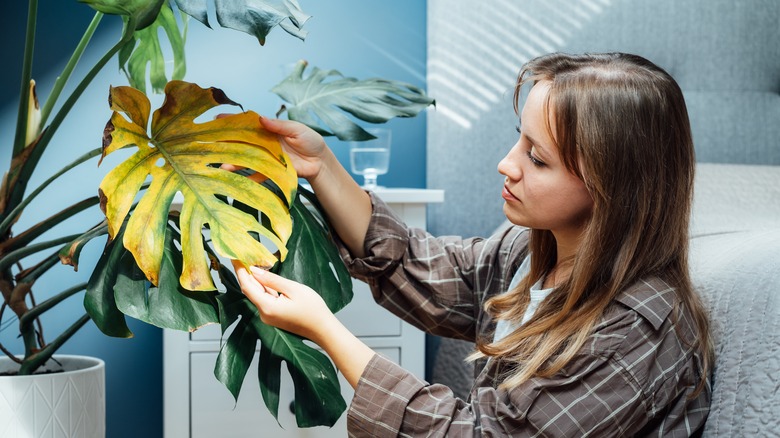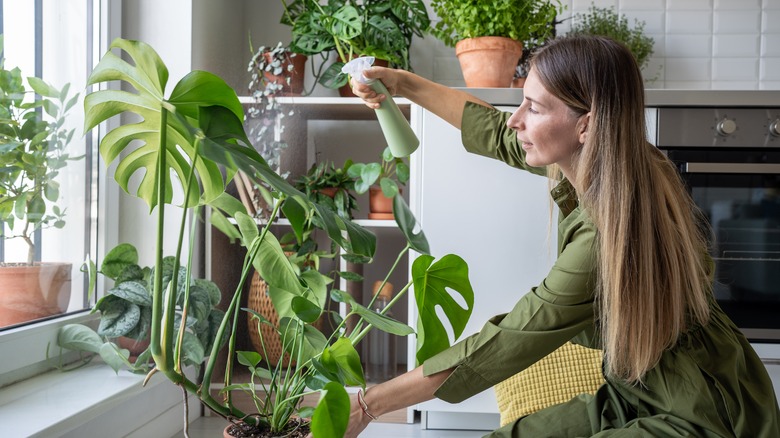Why Your Swiss Cheese Plant Leaves Are Ripping (& How To Fix It)
Raising a Swiss cheese plant can be an extremely gratifying practice, watching as each new set of leaves gradually grows and develops a series of naturally occurring holes in its foliage. This striking feature makes these plants a go-to for homeowners looking for greenery around their space. However, these holes in the leaves shouldn't be confused with unnatural rips and tears on the surface of your plant. If you start to notice that your plant is developing damage on the surface of its leaves, there are a few ways to treat those rips and help prevent them in the future with some simple environmental changes.
One of the main culprits behind ripped Swiss cheese plant leaves, otherwise known as monstera (Monstera deliciosa), is low humidity levels around your home. These plants thrive in the warm, humid environments of tropical forests and require the right conditions to survive in an indoor climate. If the air in your space becomes too dry for your monstera, its leaves will become extremely brittle and prone to significant damage. A simple bump or brush against these brittle leaves can cause them to rip and tear, threatening the plants' health. Additionally, if your monstera's leaves are already brittle, they are extremely susceptible to improper handling, making the tearing even worse. To properly deal with the tears on your onstera's leaves, it is important to understand what is causing them. You should address the humidity levels in your space, preferably between 40% and 60%, before accessing any damaged leaves. While there isn't a fix-all for torn leaves, there is a chance that your plant repairs itself.
The difference between fenestration and tears
Before you start panicking over your ripped monstera leaves, it is important to understand the distinction between fenestration and actual damage to your plant. Fenestration refers to the natural holes or splits in a mature monstera leaf that give it a competitive edge in the wild. These areas are believed to provide a number of benefits, including increased water to root systems, less resistance to the wind in tropical forests, and allowing sunlight to reach the lower leaves of the plant. While these splits might seem like a cause for concern, they are a naturally occurring phenomenon that indicates whether your plant's leaves have matured. If your monstera is healthy and well-cared for, you will start to notice more fenestration as the plant grows.
Tears, on the other hand, are entirely unintentional and tend to occur along the edges of your plant or in places where the leaf has been significantly weakened. Unlike fenestration, which creates smooth, natural curves inside the leaf, tears are often jagged, rough, and frayed on the edges. These tears can occur for a number of reasons, whether bumped while vacuuming or caught on a piece of loose clothing. You may also notice that the edges of a tear begin to turn brown, which typically indicates some kind of environmental stressor. While low humidity is the primary cause of tearing, other conditions like positioning and an improper watering schedule can also leave your Monster susceptible to this kind of damage. It is important to regularly assess your plant's health for any signs of stressors in its environment.
The solution for ripped monstera leaves
Unfortunately, there is no universal fix for damaged or ripped monstera leaves; it merely depends on the severity of the damage to your plant. Small cuts and tears can be left alone, as they shouldn't affect the plant's overall health too severely. Some of those cuts may even heal on their own if you properly grow and maintain your Swiss cheese plant. However, more significant damage to the leaves cannot be ignored and will most likely require pruning in order to make room for healthy growth. When pruning a monstera branch, cut close to the stem while preserving its node. Cutting a leaf only halfway down the stem could make it susceptible to more damage.. If one of the leaves is bent from being bumped into, you can tape a makeshift splint to the surface of the leaf. With enough time, your plant may heal itself and return to its natural state with limited scarring.
The most effective method for tackling ripped monstera leaves is to provide them with the right environment to prevent the leaves from being susceptible to breakage in the first place. Avoid keeping your monstera plant in high-traffic areas of your home, specifically spaces where it can get bumped or torn easily. Ensure that you are maintaining a proper watering schedule for your monstera plant, about once every two weeks. It should also receive a few hours of direct morning sunlight or bright, indirect sunlight throughout the day. With these conditions, you should notice your Swiss cheese plant begin to thrive and be less susceptible to significant tearing.


